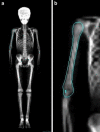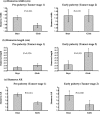Gender differences in the ratio between humerus width and length are established prior to puberty
- PMID: 17124553
- PMCID: PMC1894753
- DOI: 10.1007/s00198-006-0275-y
Gender differences in the ratio between humerus width and length are established prior to puberty
Abstract
Summary: On a sample of 1,317 children aged 9.9 years we developed a novel method of measuring humeral dimensions from total body dual-energy X-ray absorptiometry (DXA) scans and showed that gender differences in the ratio between humeral width and length are established prior to puberty.
Introduction: It is recognised that long bone cross-sectional area is greater in males compared to females, which is thought to reflect more rapid periosteal bone growth in boys. However, it is currently unclear whether these findings reflect gender differences in bone size or shape. In the present study, we investigated whether gender differences exist in the balance between longitudinal and periosteal long bone growth in children, leading to gender differences in bone shape, based on a novel method for evaluating shape of the humerus. We also examined whether these differences are established prior to puberty.
Methods: Length, area and width of the humerus were estimated from total body DXA scans in 1,317 children aged 9.9 +/- 0.33 years, who had participated in a nested case-control study of fractures within the Avon Longitudinal Study of Parents and Children (ALSPAC) (a geographically based birth cohort based in South West England). No differences were observed with respect to parameters of humeral geometry according to fracture history, and so both groups were pooled for further analysis. Aspect ratio (AR) of the humerus was calculated as humeral width divided by length. Total body height and weight were measured at the same time as the DXA scan. Puberty was assessed using self-completion questionnaires.
Results: Humeral width and length were positively associated with age and height in boys and girls combined (P<0.001), and with Tanner stage in girls (P<0.002). In contrast, age, height and Tanner stage were not related to humeral AR. We then examined gender differences in humeral shape according to pubertal stage. In prepubertal children (i.e. Tanner stage 1), humeral length was similar in boys and girls, but width (1.92 vs 1.88 cm, P<0.001) and area (47.7 vs 46.9 cm(2), P<0.001) were greater in boys, resulting in a greater AR (7.78 vs 7.53, P<0.001). Similar gender differences were observed in early pubertal children (i.e. Tanner stage 2).
Conclusion: We conclude that the greater periosteal diameter of boys compared to girls reflects differences in the balance between longitudinal and periosteal bone growth. Interestingly, resulting gender differences in humeral AR are established in prepubertal children.
Figures


Similar articles
-
Investigation of sex differences in hip structure in peripubertal children.J Clin Endocrinol Metab. 2010 Aug;95(8):3876-83. doi: 10.1210/jc.2009-2446. Epub 2010 May 19. J Clin Endocrinol Metab. 2010. PMID: 20484488 Free PMC article.
-
Calcaneal ultrasound imaging in healthy children and adolescents: relation of the ultrasound parameters BUA and SOS to age, body weight, height, foot dimensions and pubertal stage.Osteoporos Int. 2000;11(11):967-76. doi: 10.1007/s001980070036. Osteoporos Int. 2000. PMID: 11193250
-
Adipose tissue stimulates bone growth in prepubertal children.J Clin Endocrinol Metab. 2006 Jul;91(7):2534-41. doi: 10.1210/jc.2006-0332. Epub 2006 Apr 18. J Clin Endocrinol Metab. 2006. PMID: 16621904 Free PMC article.
-
Bone and body segment lengthening and widening: a 7-year follow-up study in pubertal girls.Bone. 2010 Oct;47(4):773-82. doi: 10.1016/j.bone.2010.07.007. Epub 2010 Jul 14. Bone. 2010. PMID: 20637322
-
Influence of gender and age on upper-airway length during development.Pediatrics. 2007 Oct;120(4):e1028-34. doi: 10.1542/peds.2006-3433. Pediatrics. 2007. PMID: 17908723 Free PMC article.
Cited by
-
Investigation of sex differences in hip structure in peripubertal children.J Clin Endocrinol Metab. 2010 Aug;95(8):3876-83. doi: 10.1210/jc.2009-2446. Epub 2010 May 19. J Clin Endocrinol Metab. 2010. PMID: 20484488 Free PMC article.
-
Statistical atlas-based morphological variation analysis of the asian humerus: towards consistent allometric implant positioning.Int J Comput Assist Radiol Surg. 2015 Mar;10(3):317-27. doi: 10.1007/s11548-014-1084-y. Epub 2014 Jun 13. Int J Comput Assist Radiol Surg. 2015. PMID: 24923474
-
The association of disproportionate skeletal growth and abnormal radius dimension ratio with curve severity in adolescent idiopathic scoliosis.Eur Spine J. 2010 May;19(5):726-31. doi: 10.1007/s00586-009-1247-7. Epub 2010 Jan 3. Eur Spine J. 2010. PMID: 20047062 Free PMC article.
-
The use of the pediatric physeal slide-traction plate in the treatment of neer-horwitz grade IV proximal humeral fractures in children: A case report and literature review.Front Surg. 2022 Sep 14;9:960541. doi: 10.3389/fsurg.2022.960541. eCollection 2022. Front Surg. 2022. PMID: 36189382 Free PMC article.
-
Anthropometric Scaling of Anatomical Datasets for Subject-Specific Musculoskeletal Modelling of the Shoulder.Ann Biomed Eng. 2019 Apr;47(4):924-936. doi: 10.1007/s10439-019-02207-2. Epub 2019 Jan 24. Ann Biomed Eng. 2019. PMID: 30680483
References
-
- {'text': '', 'ref_index': 1, 'ids': [{'type': 'DOI', 'value': '10.1016/j.clinthera.2004.12.020', 'is_inner': False, 'url': 'https://doi.org/10.1016/j.clinthera.2004.12.020'}, {'type': 'PubMed', 'value': '15763602', 'is_inner': True, 'url': 'https://pubmed.ncbi.nlm.nih.gov/15763602/'}]}
- Felsenberg D, Boonen S (2005) The bone quality framework: determinants of bone strength and their interrelationships, and implications for osteoporosis management. Clin Ther 27:1–11 - PubMed
-
- {'text': '', 'ref_index': 1, 'ids': [{'type': 'DOI', 'value': '10.1056/NEJMp038101', 'is_inner': False, 'url': 'https://doi.org/10.1056/nejmp038101'}, {'type': 'PubMed', 'value': '12878736', 'is_inner': True, 'url': 'https://pubmed.ncbi.nlm.nih.gov/12878736/'}]}
- Seeman E (2003) Periosteal bone formation—a neglected determinant of bone strength. N Engl J Med 349:320–323 - PubMed
-
- {'text': '', 'ref_index': 1, 'ids': [{'type': 'DOI', 'value': '10.1359/JBMR.050214', 'is_inner': False, 'url': 'https://doi.org/10.1359/jbmr.050214'}, {'type': 'PubMed', 'value': '15940373', 'is_inner': True, 'url': 'https://pubmed.ncbi.nlm.nih.gov/15940373/'}]}
- Kontulainen SA, Macdonald HM, Khan KM, McKay HA (2005) Examining bone surfaces across puberty: a 20-month pQCT trial. J Bone Miner Res 20:1202–1207 - PubMed
-
- {'text': '', 'ref_index': 1, 'ids': [{'type': 'DOI', 'value': '10.1002/ajhb.20077', 'is_inner': False, 'url': 'https://doi.org/10.1002/ajhb.20077'}, {'type': 'PubMed', 'value': '15495231', 'is_inner': True, 'url': 'https://pubmed.ncbi.nlm.nih.gov/15495231/'}]}
- Smith SL (2004) Variation in longitudinal diaphyseal long bone growth in children three to ten years of age. Am J Hum Biol 16(6):648–657 - PubMed
-
- {'text': '', 'ref_index': 1, 'ids': [{'type': 'DOI', 'value': '10.1359/jbmr.060601', 'is_inner': False, 'url': 'https://doi.org/10.1359/jbmr.060601'}, {'type': 'PMC', 'value': 'PMC2742714', 'is_inner': False, 'url': 'https://pmc.ncbi.nlm.nih.gov/articles/PMC2742714/'}, {'type': 'PubMed', 'value': '16939408', 'is_inner': True, 'url': 'https://pubmed.ncbi.nlm.nih.gov/16939408/'}]}
- Clark EM, Ness AR, Bishop NR, Tobias JH (2006) The association between bone mass and fractures in children: a prospective cohort study. J Bone Miner Res 21:1489–1495 - PMC - PubMed
Publication types
MeSH terms
Grants and funding
LinkOut - more resources
Full Text Sources
Medical
Research Materials

